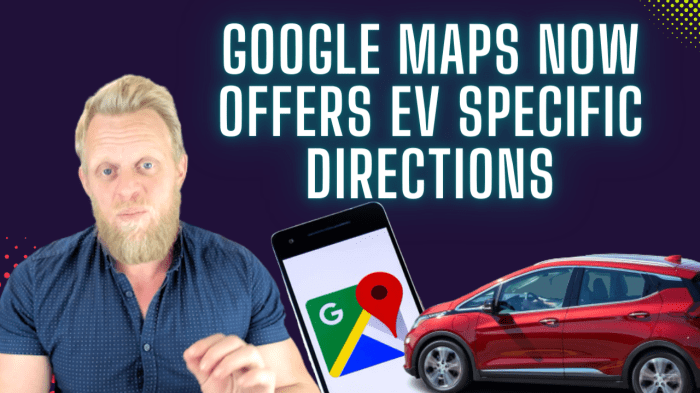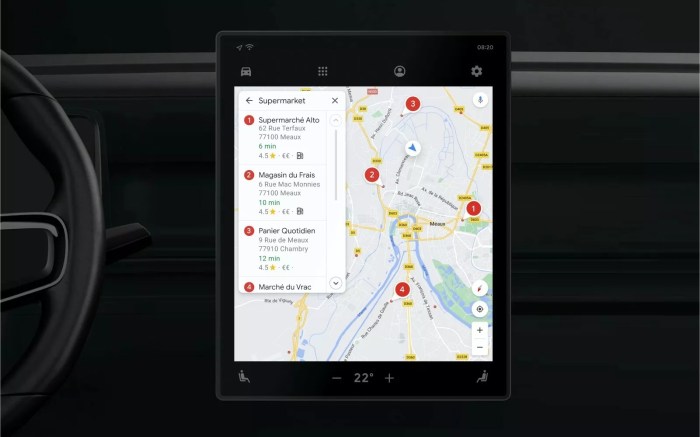Google Maps rolls out new features for EV owners, offering significant improvements to the user experience. This update promises enhanced navigation, improved charging station information, and seamless integration with other EV services. Expect easier route planning, real-time charging station details, and a more comprehensive platform for electric vehicle drivers.
The new features focus on optimizing the entire EV journey, from finding charging stations to planning routes that account for charging stops. This marks a significant step forward in supporting the growing electric vehicle market.
Overview of New Google Maps EV Features
Google Maps has rolled out significant enhancements specifically for electric vehicle (EV) owners. These updates aim to provide a more comprehensive and user-friendly experience for navigating the growing EV landscape. From detailed charging station information to improved navigation, the new features are designed to empower EV drivers with the tools they need to plan and execute their journeys seamlessly.The updates address a crucial need for EV users, particularly in areas with limited charging infrastructure.
By offering more accurate and readily accessible data, Google Maps helps EV drivers avoid range anxiety and make informed decisions about their routes. The improvements focus on providing real-time information, facilitating more efficient charging station searches, and ultimately increasing the appeal of electric vehicles for everyday use.
Charging Station Information
Accurate and up-to-date information about charging stations is essential for EV drivers. The new features in Google Maps provide comprehensive details on available charging stations, including their type (Level 1, 2, or DC Fast Charging), power output, and availability. This allows users to easily identify suitable charging options along their planned routes. Furthermore, the system displays real-time charging station status, avoiding wasted time at unavailable or occupied stations.
This improved data accuracy allows users to optimize their charging plans based on the most up-to-date availability information.
Navigation
The improved navigation features in Google Maps optimize routes for EV drivers by considering factors such as charging station locations and available charging power. This allows for more efficient and convenient journeys. Users can now input specific charging requirements, like desired charging speed, and the system will automatically incorporate these preferences into the route planning process. This feature provides a clear and intuitive approach to incorporating charging into the overall navigation experience, avoiding unexpected delays.
Route Planning
Google Maps now offers more advanced route planning capabilities for EV drivers. The system considers charging station locations and estimated charging times to optimize the route, ensuring that drivers have enough power to reach their destinations. This innovative approach facilitates better route planning, which is crucial for EV users to account for potential charging needs. Examples include planning a trip from home to work, considering the need to charge at a particular location.
Table of New Features
| Feature Category | Description |
|---|---|
| Charging Station Information | Displays real-time availability, type, power output, and location of charging stations. |
| Navigation | Optimizes routes for EV drivers by incorporating charging station locations and power levels. |
| Route Planning | Considers charging station locations and estimated charging times to optimize routes for EV users. |
Charging Station Enhancements
Google Maps’ new EV features significantly improve the user experience for electric vehicle (EV) owners, and the charging station enhancements are a key component of this improvement. The updates prioritize accurate and up-to-date information, empowering drivers to plan their journeys with confidence, knowing the charging stations along their route are reliable and available.The improved charging station information on Google Maps will display crucial details, including availability, charging speed, connector type, and estimated costs, all in a user-friendly format.
This comprehensive information will help drivers make informed decisions about their charging stops, maximizing their EV journeys and minimizing range anxiety.
Charging Station Availability and Details
The new Google Maps interface provides a clear indication of charging station availability. Instead of just a “yes” or “no,” the display will show a real-time status, enabling users to determine if a station is currently operational. This real-time availability data will be crucial for avoiding wasted time at stations that are offline or unavailable. Details like the number of charging stalls available and their current usage rate will be clearly visible.
Real-Time Charging Station Status Updates
Real-time updates on charging station status are essential for EV drivers. The updated Google Maps features aim to provide this, using data from various sources. This dynamic information will reduce the risk of wasted trips to unavailable stations. This is a significant improvement over previous static information.
Filtering by Charging Speed, Connector Type, and Cost
These new features allow drivers to filter charging stations based on their specific needs. Users can choose to see only stations offering a particular charging speed (e.g., fast, rapid, ultra-fast). They can also filter by the type of connector (e.g., CCS, CHAdeMO, Tesla Supercharger). Finally, drivers can specify a desired price range to avoid unexpected costs. These filters streamline the search process and save time.
For example, a driver planning a long trip might select only rapid charging stations to optimize their route.
Comparison of Old and New Charging Station Information Displays
| Feature | Old Display | New Display |
|---|---|---|
| Availability | Basic “available” or “not available” | Real-time status, number of available stalls, current usage |
| Charging Speed | No filtering option | Filter by charging speed (e.g., fast, rapid, ultra-fast) |
| Connector Type | No filtering option | Filter by connector type (e.g., CCS, CHAdeMO, Tesla Supercharger) |
| Cost | No cost information | Estimated cost per hour or session, allowing users to filter by price range |
| Real-time updates | Static information | Dynamic real-time updates on charging station status |
Navigation and Route Planning: Google Maps Rolls Out New Features For Ev Owners
Google Maps has always been a powerful tool for navigation, but the addition of enhanced EV features makes it even more valuable for electric vehicle owners. This improved integration streamlines the entire route planning process, considering charging needs and optimizing the journey for electric vehicles.The new navigation features significantly impact the efficiency of EV journeys. By incorporating charging station information directly into route calculations, drivers can plan trips with confidence, avoiding range anxiety and ensuring a seamless experience.
This proactive approach to route planning empowers drivers to take advantage of the charging infrastructure available, thereby maximizing their EV’s range and minimizing downtime.
Optimized Route Planning for EV Trips
Route planning for EVs involves more than just calculating distance and time. It requires factoring in the availability and location of charging stations along the route. Google Maps now proactively identifies the optimal charging stops, considering the vehicle’s range, the charging station’s type (fast, slow), and the estimated charging time. This allows drivers to anticipate potential delays and adjust their plans accordingly.
This dynamic route planning also accounts for potential traffic conditions and other real-time data, which is crucial for achieving the best possible trip time.
Incorporating Charging Stations into Route Planning
Google Maps integrates charging station information seamlessly into the route planning process. Drivers can specify their desired charging speed (fast, medium, or slow) and the app will incorporate those preferences into the route calculations. The algorithm analyzes charging station availability and estimated charging times to determine the most efficient charging stops, minimizing the overall trip time and maximizing the utilization of the available charging infrastructure.
Examples of Improved Route Planning for Long-Distance Trips
Consider a long-distance trip from San Francisco to Los Angeles. Using the standard route planner, the trip might take a certain amount of time, but the new Google Maps EV features will offer an optimal route with strategically placed charging stops. Instead of a single long driving segment, the route would be segmented with charging stops at optimal locations, maximizing the EV’s range and minimizing the need for extended charging sessions.
This results in a more predictable and comfortable journey. Another example would be a trip to a specific location with limited or no charging stations. The app will proactively suggest the closest alternative, minimizing the impact of these conditions.
Google Maps’ new EV features are a welcome addition, making navigation smoother for electric vehicle drivers. However, consider the potential of soc transformation with 10 gb free identity data ingestion for optimizing EV charging infrastructure and route planning. Ultimately, these advanced features will enhance the entire experience for electric vehicle users.
Navigation Options for EV Drivers
| Navigation Option | Benefits for EV Drivers |
|---|---|
| Fastest Route (with Charging) | Prioritizes the fastest overall travel time, factoring in charging times. |
| Shortest Route (with Charging) | Prioritizes the shortest route, optimizing charging stops for minimum distance traveled. |
| Route with Fastest Charging Stations | Prioritizes charging stops with the fastest charging speeds. |
| Route with Specific Charging Station Types | Allows users to select the preferred type of charging station (e.g., DC Fast Chargers) and plan accordingly. |
Each option caters to a different priority, allowing drivers to customize their route planning based on their individual needs and preferences. These options provide greater control and flexibility in planning electric vehicle trips.
Integration with Other Services

Google Maps’ new EV features are not isolated; they are designed to seamlessly integrate with existing EV-related services and platforms, creating a more comprehensive experience for electric vehicle owners. This interconnectedness promises a more intelligent and user-friendly navigation system for drivers. The integration strategy is crucial for fostering a robust ecosystem around EVs, encouraging adoption, and ultimately, accelerating the transition to sustainable transportation.The integration of Google Maps with other EV-related services creates a powerful synergy.
This synergy goes beyond simple data sharing, offering users a unified view of their charging options, route planning, and even subscription services, all within a familiar and intuitive interface. This unified approach simplifies the entire EV ownership experience.
Charging Network Partnerships
Google Maps’ enhanced charging station data, now integrated with major charging networks, provides users with real-time charging station availability, pricing, and even the ability to reserve spots. This integration streamlines the charging process by providing drivers with more accurate and up-to-date information. This capability is critical for a seamless charging experience, eliminating the uncertainty of finding a charging station and reducing range anxiety.For example, integration with Electrify America allows drivers to see Electrify America stations on the map, alongside their details and availability.
This eliminates the need to use separate apps and provides a unified experience within Google Maps. Similarly, partnerships with other networks like ChargePoint and EVgo provide drivers with a wider range of charging options, crucial for long-distance travel.
Subscription Service Compatibility
The integration of Google Maps with EV subscription services is another key element. This integration could provide a comprehensive view of available charging options, combined with pricing and subscription details. For instance, a user with a subscription to a service like Blink Charging could see that service’s charging stations highlighted on the map, and their pricing within the subscription model, without having to open another app.Furthermore, this integration might allow for automatic route optimization based on subscription plans, ensuring that users get the best value for their subscription.
This feature could also enable pre-booking charging sessions directly through the Google Maps platform, further streamlining the charging experience.
Comparison with Competitors
Current mapping services are integrating EV charging data from various sources, although the level of integration varies. Apple Maps, for example, focuses on displaying charging stations, but the integration with other services and subscription platforms isn’t as robust as Google Maps’ envisioned strategy. The key differentiator is Google’s ambition to create a comprehensive, centralized hub for all EV-related information.
| Feature | Google Maps | Apple Maps | Other Competitors |
|---|---|---|---|
| Charging Station Data | Real-time availability, pricing, reservation, integration with major networks | Charging station display, limited real-time information | Varying levels of data and integration |
| Subscription Service Integration | Potential for seamless integration, automatic route optimization based on subscriptions | Limited integration, primarily focused on charging station display | Limited to no integration |
| Overall Experience | Comprehensive, unified platform for EV drivers | Focused on core mapping functions with limited EV-specific features | Differing levels of integration and focus |
Benefits for EV Owners
The benefits of these integrations for EV owners are numerous. A unified platform for charging, route planning, and subscription management significantly reduces the cognitive load associated with EV ownership. This leads to a smoother and more enjoyable driving experience, minimizing range anxiety, and promoting greater adoption of electric vehicles.
User Experience Analysis
Google Maps’ new EV features promise a significant improvement in the user experience for electric vehicle owners. The enhancements to charging station information, navigation, and integration with other services should streamline the EV journey, making it easier and more enjoyable for users. This analysis explores how these features impact usability, potential user feedback, and possible areas of confusion.
Enhanced Navigation and Route Planning
The improved navigation features for EV owners are crucial for a seamless experience. Integration of real-time charging station data enables users to plan routes that optimize charging stops, factoring in factors such as charging time and station availability. This dynamic route planning, in contrast to traditional route calculations, is a significant advancement, enabling drivers to anticipate and manage charging needs proactively.
Google Maps is rolling out some cool new features for electric vehicle owners, which is great news. However, it’s interesting to consider the broader context of EV production challenges, like the recent reports about Tesla’s Model 3 production issues, including missing parts like nuts and bolts, which potentially impact the reliability and safety of these vehicles. This article delves into the specifics of those production targets.
Ultimately, while Google Maps improves EV navigation, the bigger picture of EV production still has some hurdles to overcome. Hopefully, issues like these don’t deter further innovation in the EV sector.
For example, a user might choose a route that avoids congested areas or that prioritizes fast-charging stations, leading to a more efficient and less stressful trip.
Charging Station Enhancements
The enhanced display of charging stations is pivotal. Real-time availability, charging speed, and price information are critical for making informed decisions. Detailed station information, such as connector types and payment options, are vital. The inclusion of user reviews and ratings would further empower users to select the most appropriate station for their needs. This allows drivers to make better-informed choices, potentially reducing anxiety about finding a suitable charging station.
Integration with Other Services
Seamless integration with other services like EV charging apps or car manufacturers’ apps is essential for a cohesive user experience. This integration provides users with a comprehensive view of their EV’s charging status and maintenance needs, all within the Google Maps platform. This comprehensive approach simplifies the process, eliminating the need to switch between different apps. For example, an integrated booking system could streamline the process of reserving a charging spot.
Potential User Feedback
User feedback on the new features will likely be positive, especially regarding the improved charging station information and dynamic route planning. However, there might be some initial confusion about the new interface, particularly for users unfamiliar with EV technology. Early adopters and frequent EV drivers are expected to appreciate the advanced features and the streamlined experience.
Potential for User Confusion or Frustration
Potential confusion could arise if the interface is not intuitive or if there are inconsistencies in data presentation. For example, if charging station information is not consistently updated, users may become frustrated. Another area of potential concern is the accuracy of charging station information, especially with fluctuating availability and pricing. Clear labeling and consistent formatting are crucial to avoiding confusion and ensuring a positive user experience.
Google Maps is rolling out some cool new features for EV owners, making it easier to navigate and find charging stations. Meanwhile, the whole political scene is buzzing with the RNC declaring a VP debate winner online before it even started, which is certainly a conversation starter. Hopefully, these new Google Maps features will be just as helpful to drivers as the rest of the technology world is now finding ways to use!
User Interface Design Elements
| Element | Description | Impact on User Experience |
|---|---|---|
| Charging Station Icons | Visually distinct icons representing different charging speeds and types. | Improved visual recognition and ease of identifying charging stations. |
| Real-time Availability Indicators | Dynamic indicators showing the current availability status of charging stations. | Reduces wasted time searching for unavailable stations. |
| Route Optimization Features | Options for prioritizing charging stops and avoiding congested areas. | Reduces travel time and enhances overall efficiency. |
| Integrated Service Information | Displays charging station features, user reviews, and payment options. | Enables users to make informed decisions about charging choices. |
Accessibility and Inclusivity

Google Maps’ evolution for electric vehicle (EV) owners reflects a commitment to broader accessibility, recognizing that a diverse range of users require varying levels of support. This expanded functionality aims to remove barriers and empower all EV drivers, including those with disabilities, to easily navigate and utilize charging infrastructure.The new features prioritize inclusivity, addressing the specific needs of individuals with visual or mobility impairments, and ensuring a seamless experience for all EV owners.
The enhancements in route planning and charging station discovery directly contribute to a more user-friendly experience, making Google Maps a valuable resource for the entire EV community.
Accessibility Features for Visual Impairments
The design incorporates several enhancements for users with visual impairments. These include high-contrast mode options, audio descriptions of landmarks, and detailed instructions delivered through speech synthesis. These features make it easier for visually impaired users to navigate unfamiliar areas and identify key locations, such as charging stations.
Accessibility Features for Mobility Impairments
The platform provides improved navigation for users with mobility impairments. This includes the ability to display accessible routes, showing clear directions that are optimized for wheelchairs or other mobility aids. Furthermore, the platform displays information about the accessibility features of charging stations, helping users identify those with ramps or other features that facilitate entry.
Accessibility Features for Diverse EV Users
The platform accommodates the needs of various user groups, including those with differing levels of technical proficiency. Simple and clear instructions, alongside intuitive interfaces, enhance the usability of Google Maps for all EV owners, irrespective of their technical background.
Example Accessibility Features
- High-Contrast Mode: Allows users to adjust the display’s contrast, making text and icons more easily visible for those with visual impairments. For instance, a user with low vision can easily distinguish between different charging station types or find the entrance to a shopping mall.
- Audio Directions: Provides verbal guidance, announcing turns and landmarks. This feature is especially helpful for users who are visually impaired or have difficulty reading maps. For example, a user might receive audio cues indicating they are approaching a charging station, the next turn, or the entrance to a parking lot.
- Accessible Routes: Highlights routes optimized for wheelchairs or other mobility aids, indicating the presence of ramps, elevators, or other accessibility features at charging stations. This can be useful for users with mobility issues to find charging locations easily.
Benefits of Accessibility Features
These features significantly enhance the usability of Google Maps for all EV owners. The increased accessibility empowers users with disabilities, promoting greater independence and convenience in navigating the world.
Accessibility Feature Summary
| Accessibility Feature | Benefit for User Group |
|---|---|
| High-contrast mode | Improved visibility for users with low vision |
| Audio directions | Clear guidance for visually impaired users |
| Accessible routes | Navigation assistance for users with mobility impairments |
| Charging station accessibility information | Provides information about ramps and other accessibility features at charging stations |
Potential Impacts and Future Trends
Google Maps’ enhancements for electric vehicle (EV) owners signal a significant step towards broader EV adoption. The improved navigation, charging station information, and integration with other services are poised to reshape the EV landscape and potentially drive a surge in EV purchases. These features are more than just convenient tools; they represent a critical component of fostering a supportive ecosystem for electric mobility.The enhanced Google Maps platform for EV users is not merely a technological advancement; it is a crucial step in driving broader EV adoption.
The improved integration of charging station data and route planning functionality will streamline the EV ownership experience, addressing a major concern for potential buyers. This, in turn, has the potential to significantly impact the market share of electric vehicles.
Impact on EV Adoption Rate, Google maps rolls out new features for ev owners
The improved usability and accessibility of EV charging information provided by Google Maps are likely to increase the comfort level of prospective EV owners. By reducing the perceived complexity of charging network navigation and offering real-time charging availability, Google Maps will contribute to a more appealing user experience. This improved experience will directly influence the decision-making process of potential EV buyers, making electric vehicles a more attractive option.
This positive perception of ease of use is a key factor in promoting EV adoption.
Effect on the Overall EV Market
The advancements in Google Maps for EVs are likely to stimulate the overall EV market by fostering trust and reducing perceived barriers to entry. Real-time charging station availability and optimized routes will improve the convenience of EV ownership, making it more comparable to traditional gasoline-powered vehicles. Increased convenience and reduced range anxiety can encourage more individuals and businesses to consider adopting electric vehicles, leading to a potentially significant increase in the market share of EVs.
Future Trends and Possibilities
Google Maps is positioned to play a pivotal role in shaping the future of electric mobility. Future trends might include dynamic route planning that considers real-time charging prices and estimated waiting times. Further integration with EV-specific services, such as maintenance scheduling and vehicle-to-grid (V2G) opportunities, is also plausible. These integrations will enhance the value proposition for EV owners and solidify Google Maps’ position as a comprehensive platform for electric vehicle users.
Integration with other services like ride-sharing platforms can also further promote the adoption of EVs.
Potential Future Developments
The future of Google Maps for EV owners holds exciting possibilities. Integration with vehicle-specific apps for real-time diagnostics, maintenance scheduling, and updates on vehicle-to-grid capabilities could be transformative. This proactive approach will support a comprehensive and user-friendly experience. A dynamic feature showing available charging stations based on different charging speeds, including DC Fast Charging, will be very helpful for drivers with different needs.
| Potential Future Feature | Description |
|---|---|
| Dynamic Pricing and Waiting Time Integration | Google Maps will display real-time charging prices and estimated waiting times at charging stations, enabling users to make informed decisions. |
| Vehicle-Specific Integration | Integration with vehicle apps will allow for real-time diagnostics, maintenance scheduling, and vehicle-to-grid (V2G) updates. |
| Charging Speed Differentiation | Google Maps will display charging stations based on different charging speeds (e.g., Level 1, Level 2, DC Fast Charging), catering to diverse user needs. |
| Integration with Ride-Sharing Platforms | Integration with ride-sharing platforms can provide a comprehensive travel solution, promoting the adoption of EVs. |
End of Discussion
Google Maps’ expanded EV features represent a substantial upgrade for electric vehicle owners. The improved charging station information, optimized navigation, and integrated services position Google Maps as a crucial tool for EV drivers. This update signals Google’s commitment to supporting the growing EV community and facilitating a more convenient and efficient driving experience.





